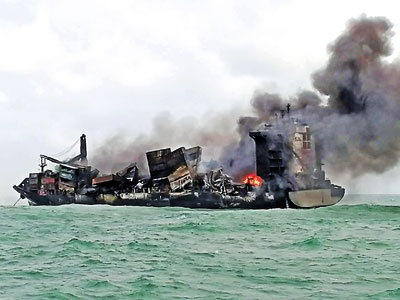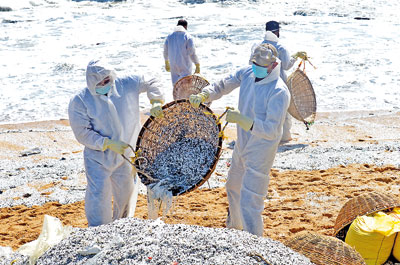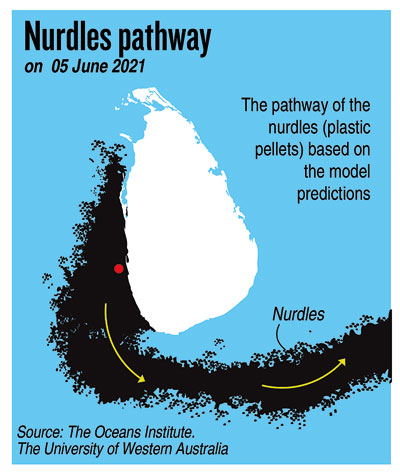News
Never be caught again with sea disasters, experts urge

Dr. Charitha Pattiaratchi
With the prospect of having a vast floating sheet of plastic pellets stretching across the entire Indian Ocean as just one consequence of the environmental damage caused by the fire on the MV X-Press Pearl, experts have called for proactive planning to deal with ship disasters as well as a continuous marine bio-diversity assessing mechanism.
“The impact to marine life from the recent ship disaster will last for decades. Preparedness is lacking and planning is only mobilised when there is a problem. We need to have structures set up to respond to marine extreme events,” Dr. Charitha Pattiaratchi, Professor of Coastal Oceanography of the Oceans Institute of the University of Western Australia, said.
Prof. Pattiaratchi who has been observing the movement of the surface chlorophyll reflecting the pathway of the nurdles (plastic pellets) released from containers of the burning and sinking X-Press Pearl off the shores of Sri Lanka, told the Sunday Times these would extend across the whole Indian Ocean from Somalia to Indonesia including India and the Maldives.
“Plastics pellets are generally not toxic but the ingestion of large quantities can cause death,” he said. “Pellets can get stuck in fish gills and also suffocate marine animals such as turtles and dolphins. The only way to reduce its impact is to remove as much as possible.”
The worst environmental damage from the sinking ship would be the potential oil spill, he emphasised.

Burning questions: The ill fated MV X-Press Pearl
According to Professor Ashoka Deepananda, head of the Department of Fisheries and Aquaculture at the University of Ruhuna, it will be difficult to assess the damage to the marine environment as Sri Lanka does not have a continuous monitoring mechanism of the marine ecosystem.
“We lack the latest data on marine biodiversity prior to the ship disaster to assess the damage caused by the fire. Lack of funding to conduct research, and lack of state intervention to obtain the latest technology or assistance from developed nations will be obstacles for the authorities who are trying to assess the damage now,” he said.
The effect of microplastics and chemicals released into the sea would only be fully evident in years to come.
“While the oil spill damage can be noticed and assessed, the damage to marine life from chemicals will show only in the coming years. This can have an impact on the life cycle of fish as larvae are sensitive to chemicals. The Negombo lagoon is rich in biodiversity and mangroves, which attracts marine species. While fish can swim to deep seas, larvae and algae will be directly exposed to the chemicals,” Prof. Deepananda said.

Deadly for marine life: Cleaning up the plastic pellets that have washed ashore. Pic by Eshan Fernando
Dr. Ravindra Fernando, Senior Professor in Forensic Science and Founder Head of the country’s only National Poisons Information Centre, said: “The ship was carrying a consignment of hazardous chemicals including 25 tonnes of nitric acid, ethyl alcohol, lead ingots, dust urea, frilled urea, high-density and low-density polyethylene (46 containers), epoxy resins (349 containers), sodium methoxide, caustic soda (42 containers), aluminum processing byproducts and raw materials for cosmetics, as well as 28 containers of raw materials used to make plastic bags. With the sinking of the ship, the release of the chemicals is a serious risk to the ocean and the coastal ecosystem.”
Prof. Fernando said the nitric acid would damage the corals and ocean life as it is a highly corrosive chemical.
“It is a very dangerous acid. The chemical spill is already causing damage to Sri Lanka’s coastline, including the popular tourist resorts of Negombo and Kalutara, with beaches thickly coated in microplastics and an oil slick visible in the surrounding ocean,” the toxicology expert said.
Prof. Fernando said the plastic pellets used to make plastic bags can be fatal to marine life and cause death to sea-turtles, fish and even birds. Dead fish have washed up on shores already with plastic pellets trapped in their gills.
The Ministry of Urban Development said 584 tonnes of plastic pellet debris from the sinking ship have been collected from the nine-kilometre stretch of coastline between Uswetakaiyawa to Sarakkukanda as a result of beach cleaning conducted by personnel from the Navy, Air Force, Coast Conservation Department and Marine Environment Protection Authority.


